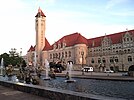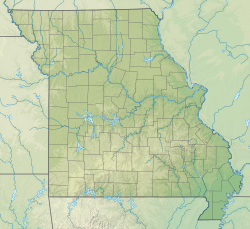This article needs additional citations for verification. (July 2024) |
St. Louis | |
|---|---|
|
| |
| Nickname(s): | |
 Interactive map of St. Louis | |
| Coordinates: 38°37′38″N 90°11′52″W / 38.62722°N 90.19778°W | |
| Country | United States |
| State | Missouri |
| CSA | St. Louis–St. Charles–Farmington, MO–IL |
| Metro | St. Louis, MO-IL |
| Founded | February 14, 1764 |
| Incorporated | 1822 |
| Named for | Louis IX of France |
| Government | |
| • Type | Mayor–council |
| • Body | Board of Aldermen |
| • Mayor | Tishaura Jones (D) |
| • President, Board of Aldermen | Megan Green (D) |
| • Treasurer | Adam Layne |
| • Comptroller | Darlene Green (D) |
| • Congressional representative | Cori Bush (D) |
| Area | |
| • Independent city | 66.17 sq mi (171.39 km2) |
| • Land | 61.72 sq mi (159.85 km2) |
| • Water | 4.45 sq mi (11.53 km2) |
| • Urban | 910.4 sq mi (2,357.8 km2) |
| • Metro | 8,458 sq mi (21,910 km2) |
| Elevation | 466 ft (142 m) |
| Highest elevation | 614 ft (187 m) |
| Population | |
| • Independent city | 301,578 |
| • Estimate (2021)[9] | 293,310 |
| • Rank | US: 76th Midwest: 13th Missouri: 2nd |
| • Density | 4,886.23/sq mi (1,886.59/km2) |
| • Urban | 2,156,323 (US: 22nd) |
| • Urban density | 2,368.6/sq mi (914.5/km2) |
| • Metro | 2,809,299 (US: 21st) |
| • CSA | 2,914,230 (US: 20th) |
| Demonym(s) | St. Louisan; Saint Louisan |
| GDP | |
| • Greater St. Louis | $209.9 billion (2022) |
| Time zone | UTC−6 (CST) |
| • Summer (DST) | UTC−5 (CDT) |
| ZIP Codes | List |
| Area code | 314/557 |
| FIPS code | 29-65000 |
| Website | stlouis-mo |
St. Louis (/seɪnt ˈluːɪs, sənt-/ saynt LOO-iss, sənt-)[11] is an independent city in the U.S. state of Missouri. It is located near the confluence of the Mississippi and the Missouri rivers. In 2020, the city proper had a population of 301,578,[8] while its metropolitan area, which extends into Illinois, had an estimated population of over 2.8 million. It is the largest metropolitan area in Missouri and the second-largest in Illinois. The city's combined statistical area is the 20th-largest in the United States.[12]
The land that became St. Louis had been occupied by Native American cultures for thousands of years before European settlement. The city was founded on February 14, 1764, by French fur traders Gilbert Antoine de St. Maxent, Pierre Laclède, and Auguste Chouteau.[13] They named it for King Louis IX of France, and it quickly became the regional center of the French Illinois Country. In 1804, the United States acquired St. Louis as part of the Louisiana Purchase. In the 19th century, St. Louis developed as a major port on the Mississippi River; from 1870 until the 1920 census, it was the fourth-largest city in the country. It separated from St. Louis County in 1877, becoming an independent city and limiting its political boundaries. In 1904, it hosted the Louisiana Purchase Exposition, also known as the St. Louis World's Fair, and the Summer Olympics.[14][15]
St. Louis is designated as one of 173 global cities by the Globalization and World Cities Research Network.[16] The GDP of Greater St. Louis was $209.9 billion in 2022.[17] St. Louis has a diverse economy with strengths in the service, manufacturing, trade, transportation, and aviation industries.[18] It is home to fifteen Fortune 1000 companies, seven of which are also Fortune 500 companies.[19] Federal agencies headquartered in the city or with significant operations there include the Federal Reserve Bank of St. Louis, the U.S. Department of Agriculture, and the National Geospatial-Intelligence Agency.
Major research universities in Greater St. Louis include Washington University in St. Louis, Saint Louis University, and the University of Missouri–St. Louis. The Washington University Medical Center in the Central West End neighborhood hosts an agglomeration of medical and pharmaceutical institutions, including Barnes-Jewish Hospital.
St. Louis has four professional sports teams: the St. Louis Cardinals of Major League Baseball, the St. Louis Blues of the National Hockey League, St. Louis City SC of Major League Soccer, and the St. Louis BattleHawks of the United Football League. The city's attractions include the 630-foot (192 m) Gateway Arch in Downtown St. Louis, the St. Louis Zoo, the Missouri Botanical Garden, the St. Louis Art Museum, and Bellefontaine Cemetery.[20][21]
- ^ a b "St. Louis United States – Visiting the Gateway to the West". Globosapiens.net. Archived from the original on May 15, 2011. Retrieved March 14, 2011.
- ^ St. Louis Public Library on "Mound City" Archived October 1, 2008, at the Wayback Machine.
- ^ STLtoday.com on "The Lou".
- ^ "Rome of the West". Stltoday.com. Archived from the original on August 10, 2017. Retrieved August 10, 2017.
- ^ "ArcGIS REST Services Directory". United States Census Bureau. Archived from the original on January 19, 2022. Retrieved August 28, 2022.
- ^ "St. Louis City, Missouri – Population Finder – American FactFinder". United States Geological Survey. October 24, 1980. Archived from the original on January 22, 2020. Retrieved December 23, 2008.
- ^ "Elevations and Distances in the United States". U.S. Geological Survey. U.S. Department of the Interior — U.S. Geological Survey. April 29, 2005. Archived from the original on November 9, 2013. Retrieved October 17, 2016.
- ^ a b "Explore Census Data". United States Census Bureau. Archived from the original on June 2, 2023. Retrieved October 7, 2022.
- ^ Cite error: The named reference
USCensusEst2021was invoked but never defined (see the help page). - ^ "Total Gross Domestic Product for St. Louis, MO-IL (MSA)". fred.stlouisfed.org. Archived from the original on October 9, 2023. Retrieved December 7, 2023.
- ^ "Dictionary and Thesaurus - Merriam-Webster". Archived from the original on October 22, 2020. Retrieved July 23, 2020.
- ^ "Metropolitan and Micropolitan Statistical Areas Population Totals: 2020-2022". Census.gov. Archived from the original on June 29, 2022. Retrieved October 27, 2023.
- ^ Cazorla, Frank; Baena, Rose; Polo, David; and Reder Gadow, Marion. (2019) The governor Louis de Unzaga (1717–1793) Pioneer in the Birth of the United States of America. Foundation, Malaga, pages 49, 57–65, 70–75, 150, 207
- ^ History: Physical Growth of the City of St. Louis. St. Louis City Planning Commission. 1969.
- ^ "A Brief History of St. Louis". stlouis-mo.gov. Archived from the original on July 26, 2023. Retrieved December 10, 2023.
- ^ "GaWC - The World According to GaWC 2020". www.lboro.ac.uk. Archived from the original on March 16, 2023. Retrieved December 7, 2023.
- ^ U.S. Bureau of Economic Analysis (January 1, 2001). "Total Gross Domestic Product for St. Louis, MO-IL (MSA)". FRED, Federal Reserve Bank of St. Louis. Archived from the original on October 9, 2023. Retrieved December 7, 2023.
- ^ "Commerce and Industry | UMSL". www.umsl.edu. Archived from the original on December 8, 2023. Retrieved December 8, 2023.
- ^ "Seven St. Louis-area companies make Fortune 500 list - St. Louis Business Journal". www.bizjournals.com. Archived from the original on January 20, 2024. Retrieved December 7, 2023.
- ^ "St. Louis Zoo named 'Best Zoo' and wins 'Best Zoo Exhibit' in Readers' Choice Awards". FOX2now.com. May 4, 2018. Archived from the original on August 2, 2019. Retrieved August 2, 2019.
- ^ "Bellefontaine Cemetery and Arboretum Level II Accreditation Listing". arbnet.org/morton-register/bellefontaine-cemetery-and-arboretum. Archived from the original on November 25, 2020. Retrieved December 8, 2021.









